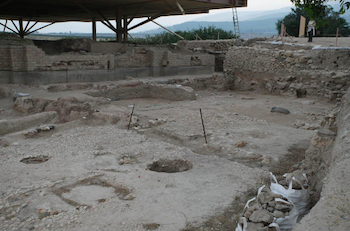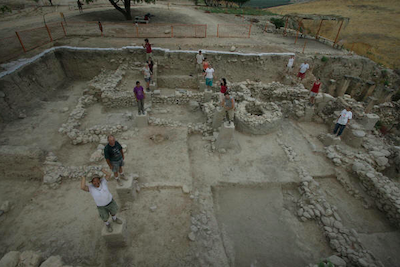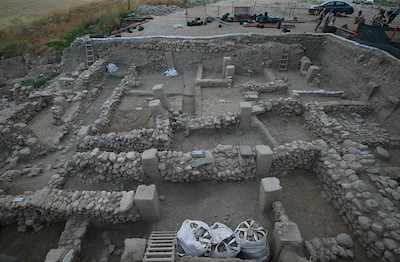The most recently announced epigraphic find from Hazor is a cuneiform tablet dating to the 18th-17th centuries BCE and containing an inscription similar to that on Hammurabi’s law code... the document includes the words “lord,” “slave” and “tooth.” Nineteen cuneiform tablets have been unearthed at Hazor since Yadin’s first season of excavation in 1956, making this the largest assemblage of such tablets from a site in Israel...
See Also: Recent Archaeological Discoveries at Hazor
By Jennie R. Ebeling
University of Evansville
December 2010
The summer of 2010 saw the 21st season of the Selz Foundation Hazor Excavations in Memory of Yigael Yadin, currently co-directed by Amnon Ben-Tor and Sharon Zuckerman of the Institute for Archaeology at the Hebrew University in Jerusalem. A number of institutions and donors have supported the project during the past decade, along with the 30-80 volunteers from around the globe – many of them Hazor veterans – who come to the site each season to take part in the excavations. Since I contributed an update of the excavations at Hazor for The Bible and Interpretation nearly ten years ago, work has continued in Areas A and M on the tell or Upper City as well as in Area S, a newly opened area in the Lower City. The following summarizes some of the highlights from recent seasons.

Area A
Excavations continued in Area A near the center of the Upper City and much conservation and restoration work have been focused in this area as well (below). Remains from the Early Bronze Age through the Mamluk period were identified, although most of the architecture dates from the Middle and Late Bronze Ages (ca. 2000-1200 BCE) and the Iron Age (ca. 1200-586 BCE) in Area A.
Some of the earliest material was reached in A5, the easternmost excavation area on the tell. Excavations in this area have focused on a complex of at least three large halls with mudbrick walls on stone foundations that have survived up to 5 meters high in places. It was initially speculated that these walls were connected to the Bronze Age fortification system that was partially exposed by Yadin, but this soon proved to be incorrect: one of the halls has a plastered floor, and no entrances were identified during the excavations, leading to the conclusion that they were subterranean.

Middle Bronze Age
The fill underneath of one of the halls contained Early Bronze Age III (ca. 2600-2300 BCE) pottery as well as a Jemdet-Nasr seal originating in Mesopotamia and dating to the early third millennium BCE, the first to be found in Israel. The halls appear to have been part of a complex founded in the Middle Bronze Age and used through the Late Bronze Age, and the question remains how these high walls remained standing for a millennium until the halls were filled in and dwellings were built on top of the area in the 8th century BCE.
Material dating from the Early Bronze Age III through the Iron Age II was also found in the southernmost excavation area, Area A4. The earliest architectural remains include a small room or installation dating to the Early Bronze III with plastered walls and a ceramic vessel from the Khirbet Kerak family found on its floor. Another plastered floor with Early Bronze IV/Middle Bronze I (ca. 2300-2000 BCE) pottery demonstrates that at least this part of the Upper City was densely occupied during this time. A cultic area was established sometime during the Middle Bronze Age (ca. 2000-1550 BCE) that contained a number of masseboth (standing stones) and offering tables; a large stone basin was also identified in Area A4. A thick layer of ashes in the cultic area contained bones, which could have been the remains of offerings or ritual meals, four small metal figurines, and many beads. The sanctuary was greatly expanded in the succeeding phase and remained in use until the end of the Middle Bronze Age.
A possible Middle Bronze Age palace with a mudbrick superstructure was exposed in this area in 2005; the walls also formed an integral part of the Southern Temple first identified by Yadin and completely exposed during excavations in the 1990s. The massive walls of this building continue under the floor of the courtyard of the Late Bronze Age ceremonial palace to the west of this area, and it has been shown that the Middle Bronze Age structure was built upon Early Bronze Age walls. Finally, a well-preserved alley with houses on both sides dating to the Iron Age II was uncovered. A window was preserved in the wall of one of the houses; the walls of these structures, which date to the second half of the 10th and the first part of the 9th century BCE, stand 1.5-2 meters in height.
Two areas, A2 and A3, have been explored to the west of the ceremonial palace.

Ceremonial Palace in the Background
In Area A2, 9th-8th century domestic structures were investigated that were built along the north and northwestern part of the palace, forming a chain of houses around it. The Late Bronze Age palace walls were still exposed during this time. A deep pit was found in the northern part of this area that contained a large number of complete Iron Age III (ca. 586-539 BCE) vessels. In the last few seasons, excavations in Area A3 have unearthed the remains of poorly constructed walls with associated ovens, two semi-circular stone installations, and floors with few Late Bronze Age pottery sherds that were covered by fallen mudbricks. The excavators believe that these structures were built during the last phase of Late Bronze Age Hazor, before the final destruction of the Bronze Age city.
Area M
Interesting work has also been carried out in Area M, which is located at the point on the northern part of the tell that is the connection between the Upper City and Lower City. In the 1990s, an impressive “podium complex” was unearthed that was uniquely paved with basalt orthostats and featured a square basalt podium set into a niche in a rear wall. The podium had four indentations on its surface and may have served as a platform for a throne or a statue. This complex appears to date to the final phase of Late Bronze Age occupation at the site; the area was consumed by the fire that destroyed much of the Late Bronze Age city. Impressive remains from the Iron Age II were also uncovered in Area M during the first decade of excavation.
More recently, the excavators have expanded Area M to the south and west with the goal of reexamining the Iron Age stratigraphy of Hazor and reaching other parts of the Late Bronze Age podium complex. Zuckerman believes that this is part of the Late Bronze Age royal palace complex and the likely location of an as-yet undiscovered archive dating to this period. Among the finds that have come to light with the expansion of the area in recent seasons are the remains of rare Persian period (ca. 539-333 BCE) domestic structures; until now, the Persian period at Hazor has been known primarily from tombs. Under the remains of the Persian period are several phases of domestic occupation dating to the 8th century in this area. Houses tend to be well built early in the 8th century, but the area appears to decline later in the 8th century as thin-walled houses that are smaller and built more closely together are found with associated courtyards, ovens, and other installations. A round, bell-shaped, and stone-lined pit was found in the middle of this area that was found to be 1.8 m. deep.

of Center in Photo
Although the function of this pit, which was not plastered, is unknown, the area around the pit included animal bones, including many fish bones, pottery sherds, and iron objects. The excavators believe that the domestic occupation in this area evidences the gradual decline leading up to the Assyrian destruction of Hazor in 732 BCE.
More pillared halls like those excavated in Area M in the 1990s were uncovered that date to the 9th century.

These halls, characterized by rows of well-cut limestone pillars, may have served an administrative function or were storehouses or stables during this period. Some of these limestone pillars were incorporated into later, 8th century, structures. During the 2010 season, the remains of a workshop used for the production of basalt vessels were found in association with one of the pillared buildings. The remains include many “wasters” or incompletely carved basalt vessels with clear chisel marks, basalt chips, and other evidence of craft production. This appears to be the first basalt vessel workshop discovered in the Near East, and its discovery may prove Hazor’s important role in the manufacture and distribution of these vessels in the Iron Age.
In 2011, excavation will continue in Area M as rooms in the Late Bronze Age royal palace will hopefully be reached.
The Lower City
In 2008, renewed excavations were opened in the lower city of Hazor in Area S, and these excavations continued in succeeding seasons as part of a three-year project. The first season of excavation produced the remains of a residential area that appears to date to the final phase of the LBII city and appears to have been abandoned rather than destroyed in a conflagration as witnessed in both the lower and upper cities. In addition to pottery and a number of small finds, botanical remains recovered through flotation shed light on diet and daily life activities during this time.
Epigraphic Finds
The most recently announced epigraphic find from Hazor is a cuneiform tablet dating to the 18th-17th centuries BCE and containing an inscription similar to that on Hammurabi’s law code (see HaAretz story at http://www.haaretz.com/print-edition/news/hammurabi-like-cuneiform-discovered-at-tel-hazor-1.304266). Now being studied by Wayne Horowitz of the Hebrew University, the document includes the words “lord,” “slave” and “tooth.” Nineteen cuneiform tablets have been unearthed at Hazor since Yadin’s first season of excavation in 1956, making this the largest assemblage of such tablets from a site in Israel; the variety of texts may indicate, as Ben-Tor believes, that scribes worked at Hazor in the Bronze Age. Other epigraphic finds include a clay Babylonian liver model and an inscribed fragment of an Egyptian statue that belongs to the “offerings made by the king” type. Both were found in Area A during the 2007 season.
Conservation Efforts
Much effort has been directed toward conservation efforts at Hazor during the past decade in Area A at the center of the Upper City. The most dramatic addition to the upper city is a protective roof that was constructed over the ceremonial palace.

Various parts of the palace and its courtyard have been restored as well; removable covers were placed on the palace’s northern and western walls, wooden trunks were placed on the basalt bases of the palace porch, wooden beams were inserted into some of the mudbrick walls, and wooden door jambs were placed at the entrance to the throne-room. Restoration work was also done on the six-chambered Solomonic gate unearthed by Yadin; the façade was raised and some of the side walls were reinforced. The southern temple partially unearthed by Yadin was also restored, as fifty years of exposure had begun to erode some of the walls. This work will not only protect and preserve the exposed architectural remains, but it will also make Area A more accessible for visitors.
More information about the Hazor Excavations can be found on their website:
http://unixware.mscc.huji.ac.il/~hatsor/hazor.html
All photos courtesy of the Hazor Excavations.
Selected Bibliography
Ben-Ami, D.
2006 “Mysterious Standing Stones: What Do These Ubiquitous Things Mean?” BAR 32/2: 38-45.
Ben-Tor, A.
2006 “Hazor,” 2006. IEJ 56/2: 216-220.
2005 “Hazor,” 2005. IEJ 55/2: 209-216.
2004 “Hazor,” 2004. IEJ 54/2: 230-235.
Ben-Tor, A. and S. Zuckerman.
2007 “Hazor,” 2007. IEJ 57/2: 211-215.
2008 “Hazor,” 2008. IEJ 58/2: 230-234.
Franz, G.
2010 “LB Palace, Here We Come!”: Reflections on the 2010 Season at Hazor. Associates for Biblical Research.
Shtull-Trauring, Asaf.
2010 “Hammurabi-like” cuneiform discovered at Tel Hazor. Haaretz.com 27/7/10.
Zuckerman, S.
2008 “The Lower City of Hazor,” 2008. IEJ 58/2: 234-236.
2006 “Where is the Hazor Archive Buried?” BAR 32/2: 28-37.
Comments (2)
Jennie,
Thank you for the update. After viewing your photo of the pillared halls in area M, I was struck by the remarkable similarity to the stable that was recently uncovered at Khirbet Qeiyafa.
See - http://lukechandler.wordpress.com/page/2/
#1 - Arthur Chrysler - 12/05/2010 - 02:04
The Area M picture showing people standing on the pillars is from 1993-1994. I was on the 1993 Hazor dig. I recognize most of the people shown.
#2 - Matt Stocking - 07/10/2013 - 18:04
